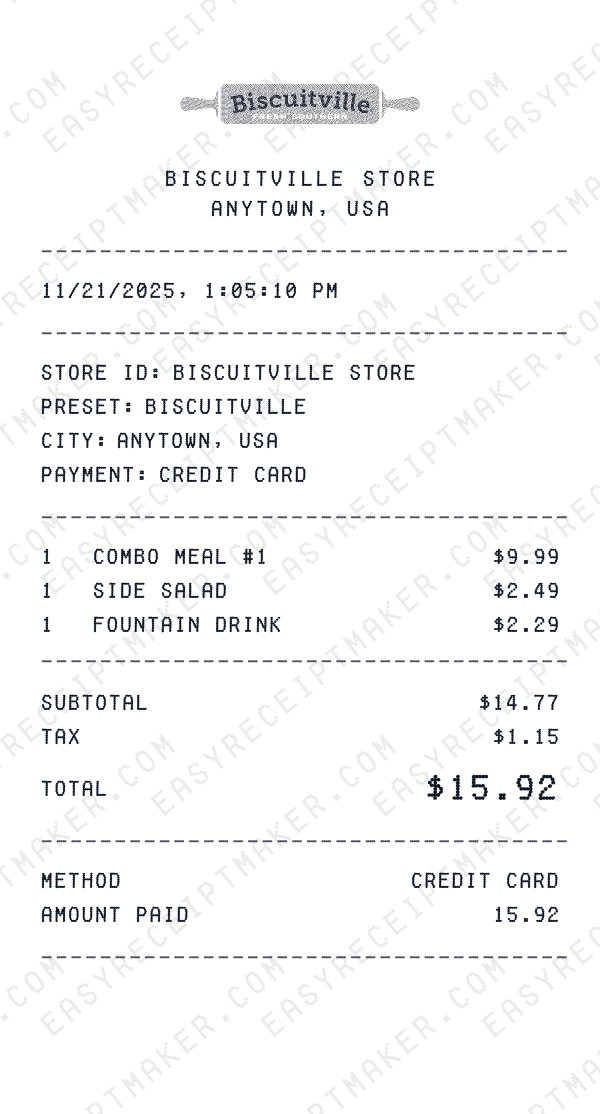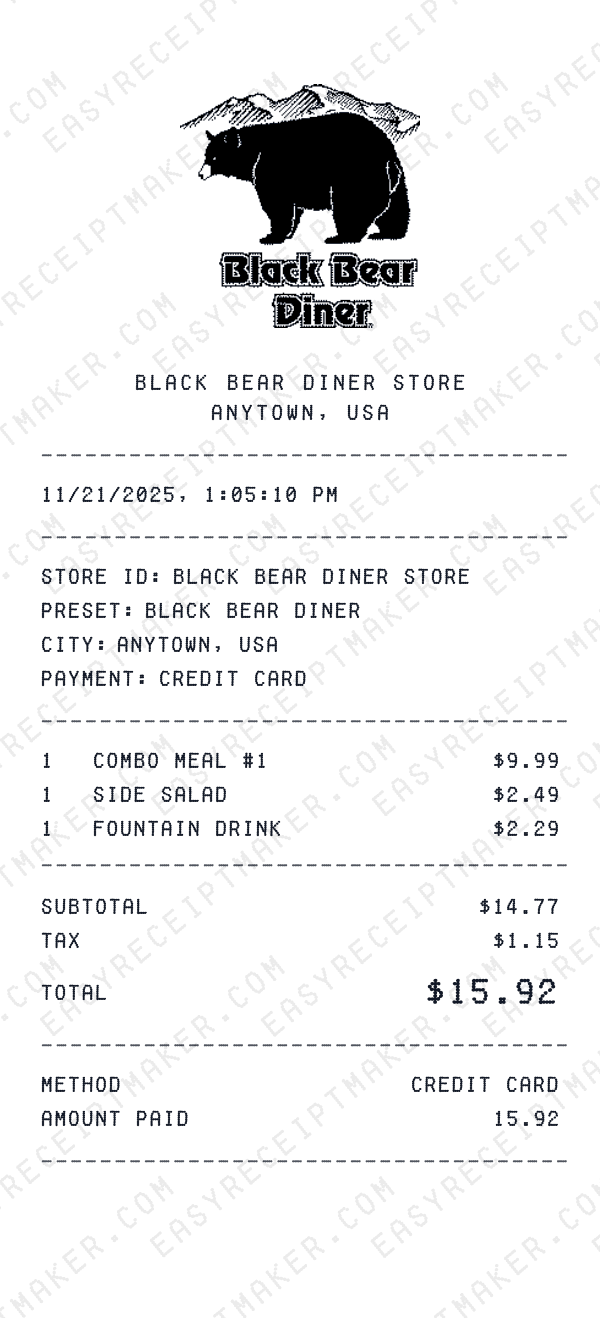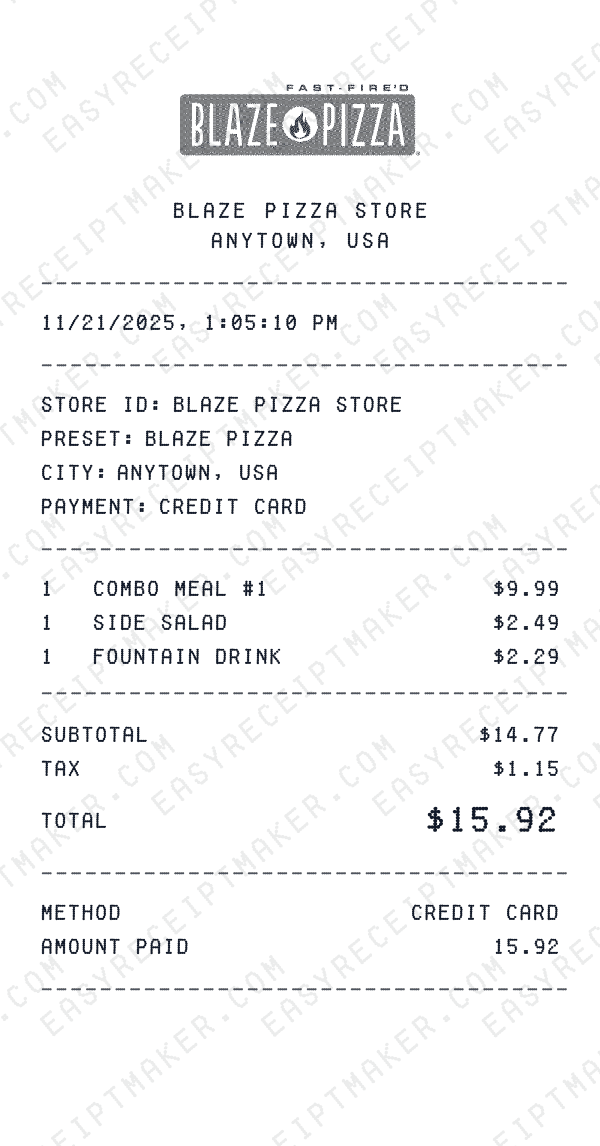Dining & meal expenses
Restaurant Receipt Maker
Recreate lost restaurant receipts for client dinners and business meals. Generate itemized bills with menu items, tax, tip, and payment details.
Replace your lost restaurant receipt
Did you lose your receipt for a client dinner, team lunch, or business meal? Whether it's a crumpled slip left at the table, a faded thermal printout, or an email confirmation that never arrived, missing restaurant receipts can stall expense reimbursements and complicate meal deduction claims. Our restaurant receipt maker helps you reconstruct the meal for your records with all required details: restaurant name and location, date and time, itemized menu items, subtotal, tax, tip, and payment method. The generated receipt mirrors the format of real restaurant bills, making it suitable for corporate expense systems and IRS documentation.
Restaurant receipts are among the most frequently lost expense documents. Diners often leave receipts at the table, spill drinks on them, or toss them in the trash along with napkins. When you need to reconstruct a business meal, the IRS Cohan Rule allows you to estimate meal expenses when original records are unavailable, provided you have supporting evidence like credit card statements, calendar entries showing the client meeting, or photos of the meal. This receipt generator helps you create professional documentation that pairs with your supporting evidence to complete your expense trail.
How to create a restaurant receipt
Start by entering the restaurant name, address, and phone number. If you're reconstructing a meal from a well-known chain like Olive Garden, Cheesecake Factory, or Chipotle, the tool can auto-fill branding and typical formatting. For independent restaurants, enter the details manually. Next, add the date and time of your meal—this should align with your credit card statement and calendar appointment if the meal was business-related.
Now itemize the menu items. List appetizers, entrees, desserts, and beverages separately with their individual prices. If multiple people dined and you're the one who paid, note the guest count so reviewers understand the total. Add the subtotal, then calculate sales tax based on your local rate (typically 6-10% depending on your city and state). Enter the tip amount—usually 15-20% for full-service dining. Finally, show the payment method (credit card, cash, or company card) and download your restaurant receipt as a high-resolution image. Attach it to your expense report along with your credit card statement and a brief note about the business purpose of the meal.
Why restaurant receipts are critical for business meal deductions
Business meal expenses are 50% deductible under IRS rules, but only if you have proper documentation. The IRS requires you to keep receipts for any meal expense over $75, and those receipts must show the restaurant name, date, amount, and list of attendees (if applicable). A credit card statement alone is not enough—it shows you spent money at a restaurant, but doesn't prove the meal was business-related or provide the itemized breakdown needed for audit defense.
Corporate expense policies are even stricter. Finance teams need to verify that meals were for legitimate business purposes—client entertainment, team meetings, recruiting dinners, or employee training sessions. A reconstructed restaurant receipt with specific menu items, guest count, and location makes it easy to cross-reference with your calendar, CRM notes, and meeting agendas. When your receipt shows a meal at a steakhouse near your client's office on the same day as a logged sales meeting, approvers can quickly validate the expense and process your reimbursement. Without a detailed receipt, your claim may be rejected or require lengthy explanations.
Common scenarios for lost restaurant receipts
Many diners lose restaurant receipts before they even leave the parking lot. You hand your card to the server, sign the slip, and walk out—leaving the customer copy on the table. Or you tuck the receipt in your wallet, where it gets crumpled, faded, or mixed with a dozen other receipts from the same trip. Thermal paper used by most restaurants fades within weeks when exposed to heat or sunlight, turning your proof of purchase into a blank slip of paper by the time you need to file your expense report.
Another common issue: group dinners where one person pays and promises to forward receipts to everyone later. That forwarding step often never happens, leaving team members without proof of their portion of the meal. Or you pay with a digital wallet like Apple Pay or Google Pay, and the restaurant's email receipt system fails to send a confirmation. In these cases, your bank statement shows the charge, but you have no itemized proof of what was ordered or who attended. Reconstructing the receipt with accurate menu items and meal details fills this documentation gap and keeps your expense reports complete.
Best practices for restaurant receipt reconstruction
To make restaurant receipt reconstruction as accurate as possible, gather all supporting documentation. Check your credit card or bank statement for the exact charge amount, transaction date, and time. Review your calendar to confirm who attended the meal and the business purpose (client pitch, team celebration, recruiter dinner, etc.). If you took photos of the meal or the restaurant, those can help verify the location and what was ordered. Some people keep notes in their CRM or project management tools after client meetings—those notes can corroborate the business context of the meal.
When estimating menu items and prices, be conservative and realistic. If you remember ordering a steak, check the restaurant's current menu online to see typical entree prices. Account for appetizers, drinks, and desserts if those were part of the meal. Make sure your itemized total—before tax and tip—aligns closely with your credit card charge. A small discrepancy of a few dollars is normal (menu prices change over time), but a large gap will raise red flags during expense reviews. When your reconstructed receipt matches your bank statement and includes clear notes about attendees and business purpose, finance teams and auditors have everything they need to approve your meal expense confidently.
Get started in 1 minute
Ready to create your receipt?
Choose a template, customize the details, and download your receipt instantly. No account required.







